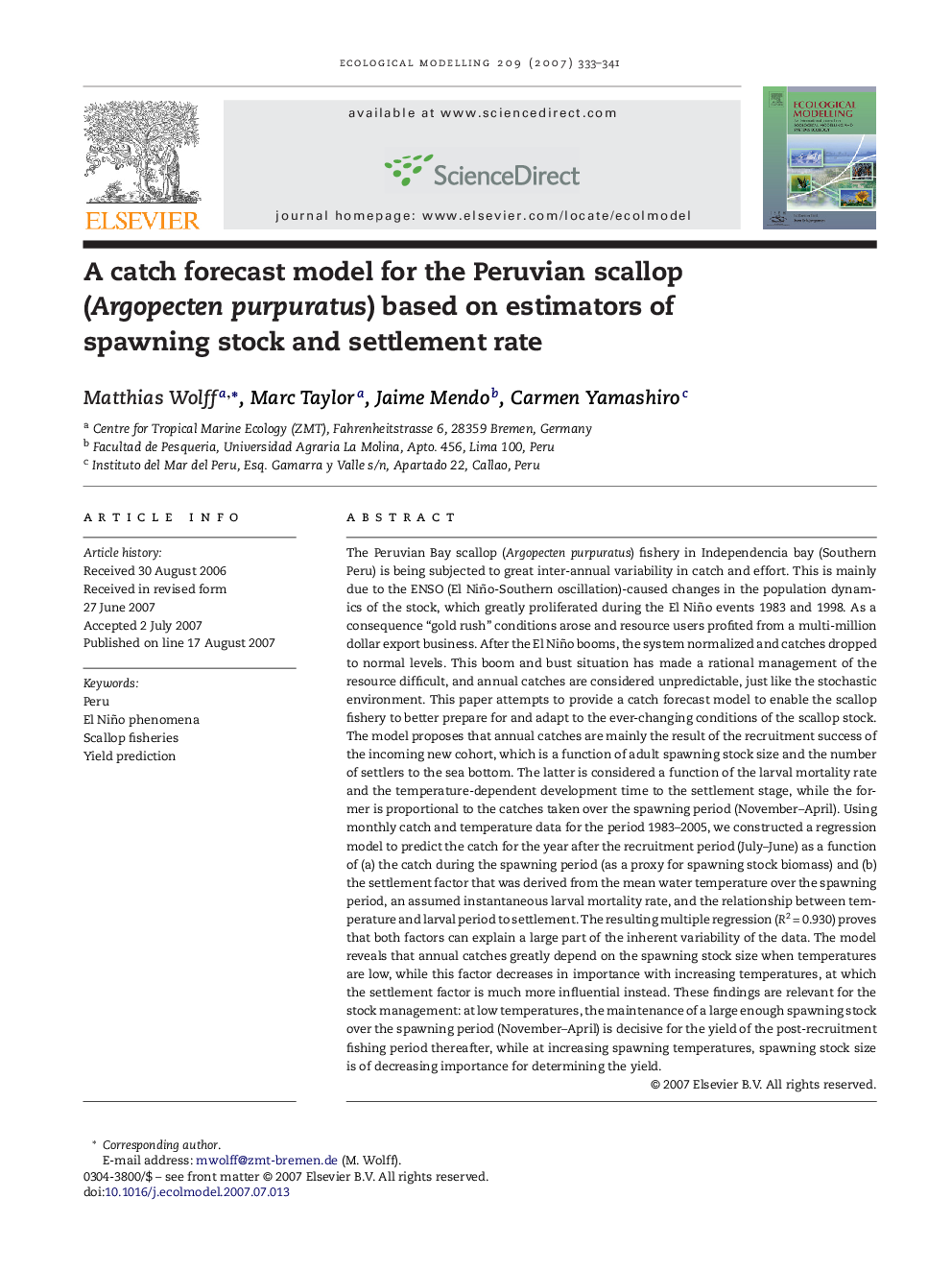| کد مقاله | کد نشریه | سال انتشار | مقاله انگلیسی | نسخه تمام متن |
|---|---|---|---|---|
| 4378532 | 1617541 | 2007 | 9 صفحه PDF | دانلود رایگان |
عنوان انگلیسی مقاله ISI
A catch forecast model for the Peruvian scallop (Argopecten purpuratus) based on estimators of spawning stock and settlement rate
دانلود مقاله + سفارش ترجمه
دانلود مقاله ISI انگلیسی
رایگان برای ایرانیان
موضوعات مرتبط
علوم زیستی و بیوفناوری
علوم کشاورزی و بیولوژیک
بوم شناسی، تکامل، رفتار و سامانه شناسی
پیش نمایش صفحه اول مقاله

چکیده انگلیسی
The Peruvian Bay scallop (Argopecten purpuratus) fishery in Independencia bay (Southern Peru) is being subjected to great inter-annual variability in catch and effort. This is mainly due to the ENSO (El Niño-Southern oscillation)-caused changes in the population dynamics of the stock, which greatly proliferated during the El Niño events 1983 and 1998. As a consequence “gold rush” conditions arose and resource users profited from a multi-million dollar export business. After the El Niño booms, the system normalized and catches dropped to normal levels. This boom and bust situation has made a rational management of the resource difficult, and annual catches are considered unpredictable, just like the stochastic environment. This paper attempts to provide a catch forecast model to enable the scallop fishery to better prepare for and adapt to the ever-changing conditions of the scallop stock. The model proposes that annual catches are mainly the result of the recruitment success of the incoming new cohort, which is a function of adult spawning stock size and the number of settlers to the sea bottom. The latter is considered a function of the larval mortality rate and the temperature-dependent development time to the settlement stage, while the former is proportional to the catches taken over the spawning period (November-April). Using monthly catch and temperature data for the period 1983-2005, we constructed a regression model to predict the catch for the year after the recruitment period (July-June) as a function of (a) the catch during the spawning period (as a proxy for spawning stock biomass) and (b) the settlement factor that was derived from the mean water temperature over the spawning period, an assumed instantaneous larval mortality rate, and the relationship between temperature and larval period to settlement. The resulting multiple regression (R2Â =Â 0.930) proves that both factors can explain a large part of the inherent variability of the data. The model reveals that annual catches greatly depend on the spawning stock size when temperatures are low, while this factor decreases in importance with increasing temperatures, at which the settlement factor is much more influential instead. These findings are relevant for the stock management: at low temperatures, the maintenance of a large enough spawning stock over the spawning period (November-April) is decisive for the yield of the post-recruitment fishing period thereafter, while at increasing spawning temperatures, spawning stock size is of decreasing importance for determining the yield.
ناشر
Database: Elsevier - ScienceDirect (ساینس دایرکت)
Journal: Ecological Modelling - Volume 209, Issues 2â4, 16 December 2007, Pages 333-341
Journal: Ecological Modelling - Volume 209, Issues 2â4, 16 December 2007, Pages 333-341
نویسندگان
Matthias Wolff, Marc Taylor, Jaime Mendo, Carmen Yamashiro,